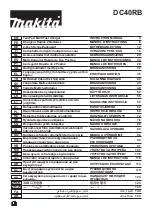
46
If the charger is damaged, stop operating it. Take it to a specialised workshop or dispose of it in an
environmentally friendly way.
If the mains cable is damaged, dispose of the damaged mains cable in an environmentally compatible
way. Do not use it anymore. Replace it with a new mains cable of the same specifications.
c) Location for Installation
•
The charger is intended for dry indoor use only. It must not become damp or wet. Never set it up near a
bathtub, shower or similar!
If the charger is operated via the mains cable, there is danger to life from electric shock in case of mois-
ture/wetness on the charger/mains cable!
•
Avoid direct sun irradiation, strong heat or cold. Keep the charger away from dust and dirt. The same
applies to any rechargeable battery that may be connected.
• Do not operate the charger inside of rooms or in bad ambient conditions where flammable gases, va
-
pours or explosive dust may be or are present! There is a danger of explosion!
• Choose a solid, flat, clean and sufficiently large surface for the charger. Never place the charger on a
flammable surface (e.g. carpet, tablecloth). Always use a suitable, non-flammable, heatproof surface.
• Keep the charger away from flammable or easily inflammable materials (e.g. curtains).
• Never cover the ventilation slits. There is a danger of overheating or fire. Never push any objects into the
ventilation slots of the charger; There is a danger to life from electric shock! Never impair the function
of the integrated fan.
•
Do not place the charger on any valuable furniture surfaces without using a suitable protection. Other-
wise, scratches, pressure points or discolourations are possible. The same applies to the rechargeable
battery.
•
Do not use the charger inside a vehicle.
•
The charger must only be set up, used or stored in places that are not accessible to children. Children
may change the settings or short-circuit the rechargeable battery/battery pack, which can lead to an
explosion. Danger to life!
• Avoid setup in direct proximity of strong magnetic or electromagnetic fields, transmitter aerials or HF
generators. This can affect the control electronics.
•
Ensure that the cables are not crushed or damaged by sharp edges. Never place any objects on the
cables.
• Do not place any containers filled with liquid, vases or plants, on or next to the charger/mains cable.
When these liquids get into the charger (or the plug connections of the mains cable), the charger will be
destroyed and there is a most severe danger of potentially fatal electric shock or fire.
If the charger is operated via the mains cable, first switch off the mains voltage for the mains socket to
which the mains cable is connected (switch off the corresponding circuit breaker or take out the fuse,
then switch off the fault interrupter protection switch (FI circuit breaker) so that the mains socket is
separated from the mains voltage on all poles). Only then unplug the mains plug of the mains cable from
the mains socket.
















































